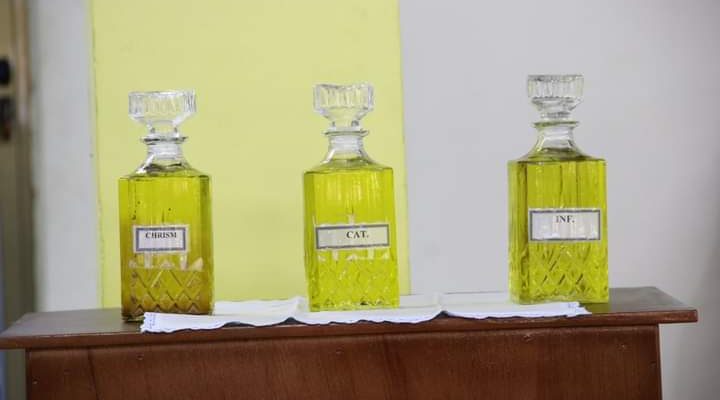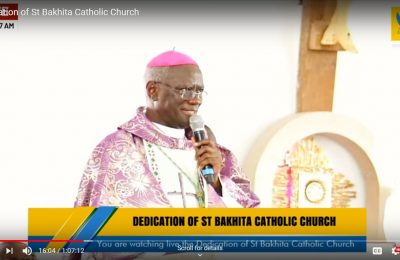The 3 oils blessed and consecrated have their various uses in the administration of the sacraments and other liturgical functions.
The Oil of Catechumens
The Oil of Catechumens is used in connection with the sacrament of baptism. St. Hippolytus, in his Apostolic Tradition (A.D. 215), wrote of an “oil of exorcism” used to anoint the candidates immediately before baptism. This practice continues: In the current baptismal liturgy, the priest offers the prayer of exorcism and then with the oil of catechumens anoints the person to be baptized on the chest, saying, “We anoint you with the oil of salvation in the name of Christ our Savior; may He strengthen you with His power, Who lives and reigns forever and ever.”
Anointing with the oil of catechumens following a prayer of exorcism may also take place during the period of the catechumenate on one or several occasions.
In both cases this anointing symbolizes the person’s need for the help and strength of God to sever the bondage of the past and to overcome the opposition of the devil so that he may profess his faith, come to baptism and live as a child of God.
The Oil of the Infirm
The oil of the infirm is used in the Sacrament of the Anointing of the Sick (formerly known as extreme unction). St. James wrote, “Is there anyone sick among you? He should ask for the priests of the Church. They in turn are to pray over him, anointing him with oil in the name of the Lord. This prayer uttered in faith will reclaim the one who is ill, and the Lord will restore him to health. If he has committed any sins, forgiveness will be his” (Jas 5:14-15).
The Apostolic Tradition of St. Hippolytus recorded one of the earliest formulas for blessing the oil of the infirm. Also, in the early Church, a priest (or several priests) would bless this oil at the time it was to be used, a tradition that has been retained in the Eastern Churches.
However, in the Latin Rite, at least since the time of the Middles Ages, priests have used oil blessed by the bishop; for instance, St. Boniface in 730 ordered all priests in Germany to use the oil of the infirm blessed by bishops only.
Presently, the priest, anointing the forehead of the person, says, “Through this holy anointing, may the Lord in His love and mercy help you with the grace of the Holy Spirit,” and then anointing his hands, says, “May the Lord who frees you from sin, save you and raise you up.” Another body part may also be anointed if the hands are not accessible or if there is another particular need.
Sacred Chrism
Finally, the sacred chrism is a mixture of olive oil and balsam, an aromatic resin. This oil is linked with the sanctification of individuals.
Regarding baptism, St. Hippolytus in the Apostolic Tradition spoke of an anointing after the actual baptism with the “oil of thanksgiving.” Similarly, right after the actual baptism in the present rite, the priest anoints the person on the crown of the head with chrism, saying, “God the Father of our Lord Jesus Christ has freed you from sin and given you a new birth by water and the Holy Spirit. He now anoints with the chrism of salvation.
As Christ was anointed Priest, Prophet and King, so may you live always as a member of His body, sharing everlasting life. Amen.”
In the sacrament of confirmation, the bishop anoints the forehead of the candidate with chrism saying, “Be sealed with the gift of the Holy Spirit.”
Sacred chrism is also used in the sacrament of holy orders. In the ordination rite of a priest, the bishop anoints with chrism the palms of each new priest. In the ordination rite of a bishop, the consecrating bishop anoints the head of the new bishop.
The Sacred Chrism is also used in the dedication ceremony of a church. Here the bishop anoints the altar, pouring sacred chrism on the middle of the altar and on each of its four corners. It is recommended that the bishop anoint the entire altar. After anointing the altar, he anoints the walls of the church in 12 or four places marked by crosses.
Let us pray for our bishop and the priests who are the ministers of the sacraments in the parish, that they may be the humble and generous servants of the Lord.
Compiled by: Rev. Fr. Anthony Ahiabor




















Congratulations to Fr Akesse.And may the good Lord in his mercy continue to bless and protect all the religious. Grant them the patience to be able to shaped the flocks you the good Lord has left in their hands. Amen 🙏🙏🙏.